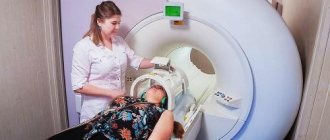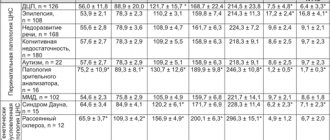Is MRI safe?
The main advantage of MRI, in addition to its high informativeness for diagnosis, is the absence of ionizing radiation .
The MRI method is based on the electromagnetic characteristics of hydrogen atoms, which quantitatively predominate over other particles in human tissue. A constant high-power magnetic field is maintained inside the tomograph; radio signals with a frequency close to the vibration frequency of hydrogen pass through it. Due to resonance, the radio wave is amplified, which is recorded in a special matrix and converted by a computer into an image.
Since different tissues of the human body contain different amounts of hydrogen, the outgoing signals from different organs and tissues differ significantly, which makes it possible to obtain fairly accurate images.
There is no medical evidence that this procedure is harmful to health or causes any complications. Among the millions of people who have undergone magnetic resonance imaging, there have been no cases of ill health or harm to the body after the examination.
The only inconvenience for the patient when conducting magnetic resonance imaging is the duration of the study. An MRI scan can take anywhere from 15 minutes to 1 hour. During this period, the patient should lie still . The examination itself is an absolutely painless procedure ; the effect of magnetic waves does not cause any discomfort to the patient.
Is MRI dangerous for health?
Magnetic resonance imaging involves exposure of the body to an alternating magnetic field, which differs from X-ray radiation. The latter, if diagnostic procedures are abused, can affect tissues and stimulate the formation of free radicals. Oxidative processes disrupt biochemical reactions in cells. This is fraught with damage to the genetic material, the development of diseases and malignant transformation of tissues.
Whether tomography is harmful can be understood from the essence of the procedure. The magnetic field affects the hydrogen atoms in the water molecules of the body's cells. After the cessation of exposure, the microparticles return to their normal state. There are no formations of dangerous compounds or structural changes in cells.
MRI scan of a pregnant woman (the arrow indicates the fetal brain)
How often can an MRI be done?
MRI is prescribed for various pathologies of the substance and blood vessels of the brain, paranasal sinuses, diseases of the spine and spinal cord, joints, abdominal and pelvic organs. This study is carried out as necessary. As a rule, an initial MRI allows you to clarify the diagnosis and prescribe treatment. A repeat MRI examination is prescribed to clarify the condition of an organ or system after surgery, to monitor the treatment process, and for a more refined diagnosis using a contrast agent.
Since electromagnetic waves do not cause radiation exposure to the human body, unlike X-ray examinations, MRI can be done as often as required for diagnosis and effective treatment. Thanks to the constant improvement of computer technology, the MRI procedure has become absolutely safe for the public, and at the same time the most informative for the doctor.
Side effects after MRI with contrast
The drug gadolinium, which is classified as a hypoallergenic, non-toxic agent, is used as contrast enhancement in magnetic resonance imaging. Chelates (soluble salts) of this substance do not affect health and are completely eliminated from the body.
An allergic reaction when receiving a contrast solution occurs extremely rarely and usually to additional components. It may appear as follows:
- hyperemia, swelling at the injection site;
- itching, skin rashes;
- signs of Quincke's edema;
- anaphylactic shock.
Patients prone to allergies should notify their doctor and discuss the use of antihistamines.
Patients suffering from end-stage renal and liver failure are prohibited from undergoing contrast-enhanced MRI. Removing the solution from the body increases the load on these organs, which can cause decompensation of chronic processes.
Complications such as systemic nephrogenic fibrosis, acute kidney damage and retention of soluble gadolinium salts in the body are extremely rare. Prevention of these conditions involves the use of macrocyclic variants of the amplifier and compliance with restrictions on the use of contrast in persons with decompensated diseases of the filtration organs.
With severe cardiovascular pathologies, patients note a deterioration in their general condition: headaches, increased or decreased blood pressure, weakness, nausea. The causes of side effects are increased permeability or disruption of the integrity of the walls of blood vessels, changes in the tone of veins and arteries.
After MRI of the brain, the state of health worsens in patients with autonomic disorders. Side effects may occur during the scan or for up to an hour after the procedure. If during the examination the head suddenly hurts, the heartbeat increases, or shortness of breath appears, the patient must contact the specialists via an intercom and report his feelings. If necessary, the scan will be stopped and the patient will be provided with medical assistance.
Pain in the head area can be caused by cervical osteochondrosis. The need to maintain a motionless body position lying on your back for 40 minutes leads to disruption of blood flow in the great vessels.
In cases where, after an MRI with contrast, you feel dizzy, have fever or chills, dyspeptic disorders, or abdominal pain, you should consult with your doctor and discuss the need to take medications. Often negative consequences indicate pathological processes and serve as a reason for additional examination.
It is not recommended to do contrast MRI on an empty stomach (with the exception of studies of the abdominal and pelvic organs) and immediately after eating (with a full stomach). A feeling of heaviness in the abdominal area leads to discomfort during prolonged scanning.
Absolute contraindications to the use of a magnetic field for diagnostic purposes are:
- the patient has metal implants, prostheses, pins, etc.;
- the presence of implanted electromagnetic devices in the body (pacemakers, insulin pumps, etc.);
- the subject has tattoos made with metal-containing inks.
The patient should warn the doctor about the restrictions. If after an MRI with contrast the patient feels unwell, a metallic taste appears in the mouth, or the general condition sharply worsens, you should make sure that safety measures are followed.
Patients suffering from claustrophobia experience discomfort from being in the confined space of a tomograph tube. A panic attack may be accompanied by side effects:
- tachycardia;
- feeling of suffocation;
- nausea;
- pain in the abdominal area;
- dizziness, etc.
Restoring normal well-being after an MRI with contrast takes 1-2 days, during which time it is recommended to avoid increased stress and fatigue.
Contraindications for MRI
In some cases, MRI can cause some harm to health, and therefore doctors do not prescribe this research method to the patient. Common reasons for refusing magnetic tomography include:
- The first trimester of pregnancy (absolute contraindication), the second and third trimesters - for health reasons, strictly individually;
- The presence in the patient’s body of various metal implants for medical purposes (pacemakers, hemostatic clips applied to the vessels of the brain, wires in the bones, orthopedic structures, artificial joints, etc.);
- Fear of closed spaces (claustrophobia);
In addition, there are a number of absolute and relative contraindications to MRI.
Is MRI of the brain dangerous?
MRI does not involve radiation exposure, so there is no harm in performing the scan. During the procedure there is only exposure to a magnetic field. During the examination, the body of an adult or child is not exposed to ionizing radiation, which can cause harm. Therefore, the range of contraindications is extremely narrow.
Some patients are concerned about the question: “Is MRI of the brain dangerous and how harmful is it during pregnancy, in an adult or in childhood?” The essence of the procedure does not change. The diagnosis is not harmful to the listed groups of people. Due to insufficient information and lack of objective data on the effect of the procedure on organogenesis, MRI is not performed on early pregnant women. But since it is believed that it is potentially harmless, if the life of the mother is threatened or if deformities in the child are suspected, in consultation with the doctor, a scan may be prescribed.
MRI of the brain is often done with contrast, using for this purpose the additional injection of a gadolinium-based drug into the bloodstream. The indicator increases the vibrations of hydrogen protons and makes images clearer. Contrast studies are not used during pregnancy at any stage, since it has not been studied how harmless it is for the fetus.
Contraindications to MRI scanning are:
- the presence of implanted electronic devices in the patient’s body (pacemakers, insulin pump, etc.);
- metal structures made of ferromagnetic alloys (knitting needles, plates, hemostatic clips, etc.).
MRI of cerebral vessels
The above limitations exist due to the ability of the magnetic field to damage electronics. Therefore, performing diagnostics on people with metal implants cannot be called safe or harmless. Ferromagnets can change their position and heat up. If the structure is outside the impact area, this is safer, but is still discussed on an individual basis. If there are metal implants in the head, negative consequences are possible. If the patient has a titanium element installed, there will be no harm, since such structures do not react to the magnetic field.
Claustrophobia and excess weight are considered relative contraindications. In such cases, you will have to do an MRI using open-type machines. For children, patients with acute pain syndrome and psychoneurological disorders, the procedure can be performed under anesthesia with the assistance of additional specialists.
MRI for a child
For young children, MRI examinations are performed according to strict clinical indications in specialized clinics, usually using anesthesia. If it becomes necessary to have an MRI performed on an older child, parents should explain to him that the examination does not cause pain. The only inconvenience can be the loud sound of the tomograph (earplugs are required) and the duration of the examination procedure, during which it is necessary to lie still.
If diagnosing a disease in a child is possible without magnetic resonance imaging, then pediatricians try not to prescribe the study due to the inconvenience that is difficult for the baby to bear. If the study is still necessary, and the child is unable to remain motionless, sedatives and anesthetics are used. An MRI of a child under anesthesia is possible strictly after consultation with an anesthesiologist .
The effect of MRI on the human body
Contraindications allow us to understand why tomography can be dangerous. MRI scans are not performed on patients with metal or electronic implants:
- pacemaker;
- defibrillator;
- insulin pump;
- pins, knitting needles;
- vascular stents or clips;
- endoprostheses;
- Ilizarov apparatus, etc.
The restrictions are due to the risk of failure of electronics or changes in the properties of metal structures. Devices made of alloys are attracted to a magnet and heat up. The degree of influence is determined by the location, size and shape of the implant. MRI is allowed for people with titanium structures in the body after providing a document indicating the composition of the material.
Magnetic resonance imaging is not used to diagnose pregnant women in the first trimester due to the lack of research results confirming the safety of the procedure for the child. An exception is conditions that threaten the life of the mother or fetus.
Other contraindications are not due to the effect of MRI on the human body, but to the design features of the equipment and the nuances of the procedure. Scanning is usually not performed:
- children under 5 years of age (due to the need to lie still for a long time, which is difficult for small patients); in emergency cases, diagnosis is carried out under anesthesia in a hospital;
- persons with mental disorders;
- people with neurological diseases, severe pain, when the likelihood of involuntary movements is high;
- with a body weight over 120 kg (maximum load capacity of the closed-type tomograph conveyor), torso girth over 150 cm (limitation on the diameter of the apparatus tunnel);
- patients with claustrophobia.








